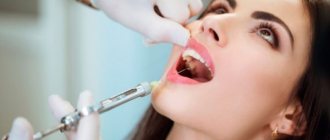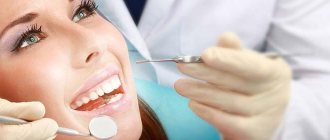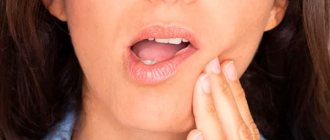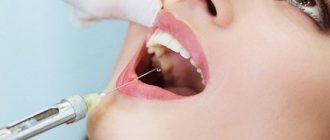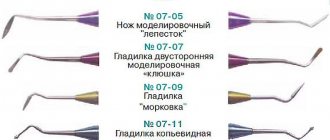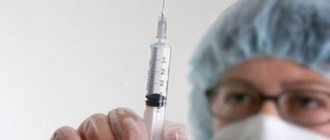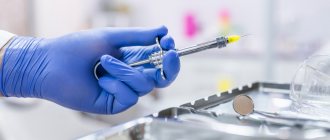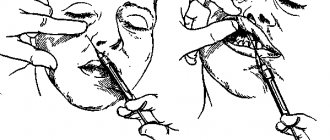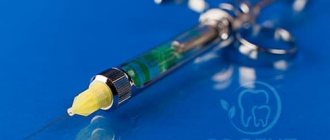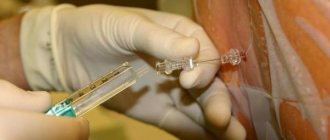We are publishing an article by Natalya Lvovna Mayorova, a dentist, therapist, and head of the therapeutic department of the Dentalika clinic.
Pain relievers used in modern dental practice can work wonders. After receiving an anesthetic injection, the patient does not feel any pain or even particularly unpleasant sensations. To ensure that the injection itself is painless, before the procedure the doctor “freezes” the injection site with a special preparation with a delicious smell of cherry, lemon, or apple.
Local anesthesia is the main method of pain relief used in dental practice. With local anesthesia, the patient remains fully conscious, and this allows the doctor to fully control the entire course of treatment, communicate with the patient, and monitor your reaction.
The quality of dental interventions depends on the results the doctor obtained during local anesthesia. Therefore, achieving 100% pain relief is necessary not only for the patient, but also for the doctor, in order to carry out treatment calmly, slowly, and efficiently. Hence the following requirements for local anesthetics:
- they must have a strong analgesic effect, easily penetrate into tissues and remain there for as long as possible;
- have low toxicity, causing a minimum number of both general and local complications
Based on these wishes, we chose several widely used drugs:
- Ultracaine DS forte (4% articaine, adrenaline 1:100,000);
- Ultracaine DS (4% articaine, adrenaline 1:200,000);
- Scandonest SVC (3% mepivacaine; without vasoconstrictors - adrenaline).
Now in more detail about their action.
Ultracain DS
The analgesic basis of the first two drugs is ARTICAINE (amide anesthetic from the thiophene series), an antispasmodic - lowers blood pressure. It is characterized by rapid action - anesthesia occurs in 0.5-3 minutes. Articaine is 2 times stronger than lidocaine and 6 times stronger than novocaine (anesthetics of previous generations), less toxic, relatively quickly eliminated from the body. Its half-life is, on average, 22 minutes, that is, all traces of the drug disintegrate in 44 minutes and are then completely eliminated from the body. Has high penetrating ability. It is distinguished by high purity of the solution. Allergic reactions to articaine are very rare - one in one hundred thousand injections ; the use of articaine, according to studies, is safe in 99.4% of cases. They also contain a vasoconstrictor (a substance that causes constriction of blood vessels and a decrease in blood flow in them) - adrenaline. The use of a vasoconstrictor continues and enhances anesthesia. The drug also contains antioxidants (sulfites) - substances that prevent the oxidation of adrenaline.
Ultracaine does NOT contain parabens (anesthetic preservatives), which significantly reduces its toxicity. In addition, parabens can cause allergic reactions.
Thus, ultracaine is:
- a strong anesthetic with moderately low toxicity, due to its components;
- the safest drug for pregnant women, because articaine does not penetrate the hematoplacental barrier - the barrier separating the blood of the fetus and the blood of the mother (Ultracaine DS).
School-age children can also use Ultracain DS. We always remember that the administration of an anesthetic solution with adrenaline is CONTRAINDICATED for children under 5 years of age, patients with pathologies of the cardiovascular system, with endocrine pathologies, taking antidepressants, thyroid hormones, drugs that block beta adrenergic receptors; - an anesthetic that practically does not require postoperative pain relief;
- a drug that provides a rapid onset of anesthesia, depending on the anesthesia tactics chosen by the doctor, the effect occurs within 30 seconds to 3-5 minutes);
The duration of anesthesia is, depending on the technique chosen by the doctor, from 1.5-2 hours to 5-6 hours. The choice of different techniques (infiltration, conduction anesthesia) depends on the planned dental procedure. For example, there is a difference between the treatment of caries of one tooth and the complex removal of a wisdom tooth. - good local and general tolerability. According to studies, only 4.3% of patients experienced toxic reactions, which was caused by the presence of adrenaline and sodium disulfate in the anesthetic solution.
- For standard procedures, a small amount of anesthetic is required (0.9 ml-1.8 ml).
I would like to note that for standard dental operations it is better to use Ultracain DS (adrenaline 1:200,000). A strong anesthetic provides high-quality anesthesia even during complex, long-term interventions, and a small amount of vasoconstrictor ensures low toxicity of the anesthetic solution. And we prefer to consider Ultracaine DS forte (adrenaline 1:100,000) as a “reserve anesthetic” in more complex situations:
- anesthesia of the lower lateral teeth (molars) for their treatment and depulpation;
- pain relief for inflammatory processes in the maxillofacial area (periostitis, osteomyelitis);
- for particularly traumatic interventions;
- in patients with a low pain threshold.
Conditions that local anesthetics must adhere to
In general, local anesthetics should:
- Do not cause allergies
- Have minimal toxicity to the body
- Have few side effects
- Easy to dissolve and excrete
In addition to this, anesthetic agents are required to:
- The effect is strong enough to completely anesthetize the tooth and surrounding tissues.
- Rapid numbness - no more than 5 minutes after the injection
- The numbness should last at least an hour - so that it is enough for the entire procedure, including the very last manipulations
- Anesthesia should take place no more than 2-3 hours later.
- Long-term stability of the drug itself – at least 2–3 years
Scandonest SVC
If the patient belongs to a risk group (with severe concomitant diseases , in particular cardiovascular pathology ), the use of an anesthetic solution with adrenaline, a vasoconstrictor, should be completely abandoned. In such cases we use Scandonest SVC . This anesthetic exhibits a vasoconstrictor effect, i.e. has vasoconstrictor properties and can therefore be used without adrenaline, which means that the drug does not contain sulfites and can also be used in patients with bronchial asthma and allergic conditions (after an allergy test). Scandonest SVC is a medium-strength anesthetic; provides anesthesia, depending on which part of the jaw the doctor disconnects from pain sensitivity, for 20 - 90 minutes, which sets it apart from the group of other non-adrenaline anesthetics.
general description
Anesthesia is administered using a special syringe, after which the sensitivity of the nerve endings of the tooth is reduced. The capsule is called carpool. The procedure for administering the medicine itself follows a standard procedure.
The carpule syringe is designed for reusable use. It is made of medical metal, and the structure includes a frame, a piston part and a needle. The piston is equipped with a gap to accommodate the capsule. The latter is a special ampoule containing an anesthetic.
The ampoule is sealed in a sealed package, which ensures the safety of properties and compliance with sanitary standards.
Allergy tests
If you have previously experienced allergic reactions to medications, you have doubts, and you do not fully know which local anesthetics are safe for you, we strongly recommend that you undergo tests for allergic reactions at an allergy center before visiting the dentist. The addresses of such centers can be obtained from the reception of the Dentalika dental clinic. The test results can be completely trusted. This recommendation especially applies to parents of children who bring their children to the dentist for the first time. Unfortunately, from year to year the number of children susceptible to allergic reactions in our city is only growing. A visit to the allergy center will completely protect your child from possible complications.
Lidocaine gel –
There are both professional lidocaine-based gels for dental clinics and those that can be bought at any pharmacy. An example of a common gel with lidocaine is the drug “Kamistad”. This gel contains lidocaine and chamomile extract as active ingredients. Created specifically for application to the oral mucosa. It has an analgesic and slight anti-inflammatory effect.
Lidocaine gel: price The cost of the drug Kamistad is about 230 rubles. If we talk about analogues for anesthesia of the mucous membrane, then the Cholisal gel has a slightly less pronounced, but longer-lasting analgesic effect. The latter also has a pronounced anti-inflammatory effect. The cost of the last drug is about 300 rubles.
Children
It should be noted separately the features of local anesthesia in children. The technique of local anesthesia in children must be planned so that 100% pain relief is achieved at all stages of treatment, otherwise it will be impossible to carry out the necessary manipulations.
As mentioned above, children under 5 years of age are given an anesthetic without adrenaline (3% scandonest SVC, or septanest 4% SVC).
Children over 5 years old can use an anesthetic with low concentration adrenaline (1:200,000 - Ultracaine DS). The dose of drugs is selected depending on age. Pain relief is performed in children in 3 stages:
- First, a superficial anesthetic gel is applied
- then a small dose (0.1-0.2 ml) of anesthetic is administered;
- after which, after 60-90 seconds (time sufficient for effective anesthesia of the needle path in the soft tissues), the remaining amount of the planned dose of anesthetic is administered.
We wait 5-10 minutes until complete anesthesia occurs. The child, feeling a complete absence of pain, gains confidence in the doctor and gives the opportunity to carry out the necessary intervention.
Advantages of carpule pain relief
The most important advantages of carpulal anesthesia can be considered:
- The exact amount of the drug in 1 ampoule is exactly 1.7 ml. Thanks to this, the doctor can count the carpules and know exactly the dosage of the administered drug.
- Complete sterility. Carpules are manufactured and sealed in a warehouse under completely sterile conditions. This way you can be sure of the quality of the injected drug.
- Less pain from the injection itself. Patients feel less pain when punctured because the needle of a carpule syringe is much thinner and more flexible than that of a regular syringe.
- It is more convenient for the doctor to control the process. The dental anesthesia carpule syringe fits very comfortably in the hand thanks to special handles and stops. Also due to the greater flexibility of the needle, it can be bent in almost any direction without fear of it breaking off.
- Elimination of errors. When using Carpules, the possibility that the doctor will administer the wrong drug or in the wrong quantity or concentration is completely eliminated. After all, with carpule anesthesia, the doctor always knows exactly what he is injecting - the name of the drug, its concentration and quantity is written on each carpule.
Failed anesthesia
I would also like to touch upon the topic of unsuccessful local anesthesia. Almost every dentist has encountered this in their practice. The reasons for this phenomenon can be classified into 2 groups:
- depending on the doctor (poor choice of anesthesia technique and anesthetic solution; errors in the technique);
- depending on the anatomical and psychological characteristics of the patient.
To eliminate psychological causes in patients with a labile psyche (with increased emotionality, sensitivity, excitability), premedication is used: sedatives and sedatives.
In all other cases, the doctor must approach the choice of anesthetic and local anesthesia technique with even greater responsibility and professionalism, starting from the very first minutes of communication with the patient (history collection).
You should always remember that there are NO teeth that cannot be anesthetized, it’s just sometimes more difficult to achieve this.
High-quality pain relief minimizes patient discomfort and allows dentists to perform the necessary interventions.
Natalya Lvovna Mayorova doctor - therapist - dentist October 2009
Dear Colleagues! When copying information, placing a link to the source site is mandatory.
General overview
The name of the technique - carpule anesthesia - comes from the special design of the syringe, with the help of which a composition is introduced into the tissues that reduces the sensitivity of the tissues. The capsule with the drug is called a “carpule” and is replaceable, which allows the device to be used repeatedly for dental procedures. For the manufacture of medical instruments, a metal alloy is used, which is safe for biological tissues of the body. The system consists of a frame and piston part, as well as a needle, while the piston is not completely removed from the body, and in the side there is a slot for placing a capsule with the drug.
An ampoule with an anesthetic, hermetically sealed along the seam, has a rubber plug on one side and a metal valve on the other. The algorithm for using a carpule syringe involves placing the capsule in the gap, followed by screwing in the needle and performing the injection. The plug is located on the opposite part - as you press the piston, the composition moves into the fabric structure, providing the desired result.
